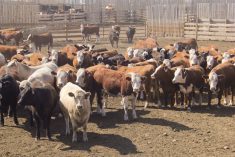U.S. feeder cattle futures fell their daily three-cent-per-pound daily trading limit on Friday as corn soared by its 40-cent-per-bushel limit, traders and analysts said.
Live cattle fell on weak cash cattle and beef markets and on hog/cattle spreading.
Hog futures gained on the spread activity as traders bought hogs while selling cattle due to the historically wide spread or difference in the premium of beef to pork, the traders said.
"Feeders were down on the corn market but I think an even bigger thing is the lower cash cattle market. Retail beef has been at 75 to 78 cents premium to pork which is the widest in history and I don’t think that can be sustained," said Jim Clarkson, a broker for A+A Trading Inc. (all figures US$).
Read Also

U.S. livestock: Feeder cattle hit contract highs on tight supply
Chicago | Reuters – All Chicago Mercantile Exchange feeder cattle futures and most live cattle futures hit contract highs on…
The U.S. Department of Agriculture’s (USDA) boxed beef report on Friday morning showed wholesale choice beef at $189.30 per hundredweight, down $2.74 per cwt and select at $178.25, down $2.26.
Clarkson said the spread or difference between cattle and hog prices was beginning to correct with some traders beginning to buy hog futures and sell cattle futures.
The move helped buoy Chicago Mercantile Exchange (CME) hogs while pressuring cattle.
At 12:03 p.m. CT, CME October live cattle were down 0.175 cent per pound at 122.275 cents/lb. and December was down 0.2 at 124.975.
CME October feeder cattle were down 1.850 cents/lb. at 144.350 cents/lb. and November was down the three cents/lb. limit at 144.325.
Each market was rattled on Friday following the release of a government report that hinted feeding expenses would be climbing, which could slash the demand for young cattle or feeder cattle destined for the country’s feedlots.
USDA shocked the market by releasing a September quarterly stocks of grain report that showed the U.S. corn supply on Sept. 1 was well below expectations.
Some traders said the demand for corn as a feed continued to be strong during the final quarter of the 2011-12 marketing year, which drew down the stocks of corn more than expected.
"There is just too much feedlot capacity. Corn down around $7 wasn’t rationing demand and I don’t know how high corn has to go to do that, maybe back to $8 or more," Clarkson said.
"We took corn from nearly $8.50 down to about $7 and now we’re going back up again," Clarkson said.
That report boosted Chicago Board of Trade (CBOT) corn futures and pressured feeder cattle since corn is the main feed ingredient for the nation’s feedlot operators.
"Cash cattle markets were down $3 to $4 per cwt and packers were unable to move beef at current prices, leaving little room for futures optimism," a trader said.
Cash cattle in the Plains traded at $122-$123/cwt, down $3 to $4 from last week as packers curb slaughter to improve their margins and underpin wholesale beef values.
The average beef packer margin for Thursday was a negative $37 per head, compared with a negative $38.50 on Wednesday and a negative $24.65 for Sept. 20.
Hog market stabilizes
Most lean hog futures contracts were higher on firm cash hog markets, positioning before the release at 2 p.m. CT of USDA’s quarterly hog inventory report and deferred months were strong relative to nearbys on bear spreading that was tied to soaring corn futures.
Keen interest was in the number of market weight hogs and number of hogs kept for future hog production that may surface in Friday’s government inventory report.
An average of analysts’ estimates in a Reuters poll placed the number of hogs in the United States at 67.705 million, up 0.7 per cent from a year ago. However, the number kept for breeding fell 0.3 per cent from a year ago while the number kept for market rose 0.8 per cent, according to the average estimate of analysts in the poll.
Correction of the wide disparity that cattle futures hold over hog futures also lifted hogs versus cattle as some traders chose to unwind cattle/hog spreads and set fresh spreads by buying hogs and selling cattle.
Spreaders sold October futures and bought deferred contracts as corn prices jumped, which could cause producers to feed fewer hogs.
Packers cut bids for hogs after topping off inventories for this week to accommodate Saturday’s slaughter, estimated at 160,000 head.
At 12:03 p.m. CT, CME October hogs were down 0.025 cent/lb. at 77.2 cents/lb. December was up 0.8 cent at 74.4.
— Sam Nelson and Theopolis Waters write for Reuters from Chicago.















